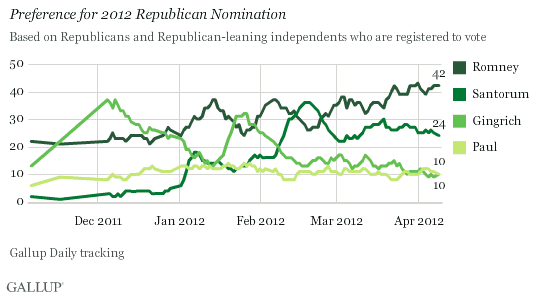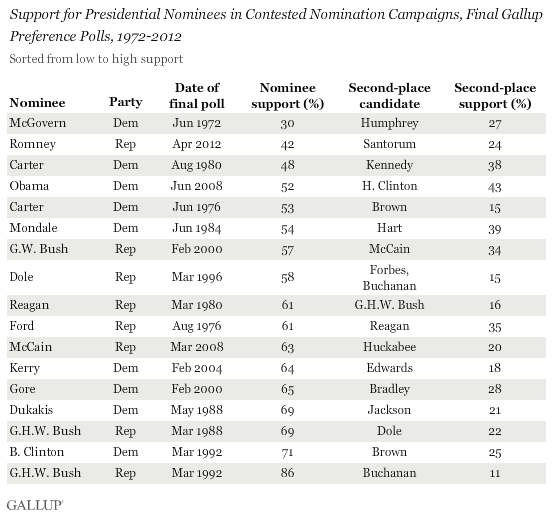PRINCETON, NJ -- Rick Santorum's announcement Tuesday that he is suspending his campaign effectively ends the GOP nomination contest and makes Mitt Romney the presumptive nominee. Romney is the preferred presidential candidate of 42% of Republican voters nationwide, with Santorum coming in second at 24%. Romney has led Santorum since late February, and has been the leader for all but two brief periods this year.

The results are based on April 4-9 Gallup Daily tracking interviews with 1,149 Republicans and Republican-leaning independents who are registered to vote. Gallup has tracked Republican voters' nomination preferences daily since December and periodically since September 2010. Gallup is now transitioning its Daily tracking to measuring general election preferences between Barack Obama and Romney, with the first results to be reported Monday, April 16.
Romney ranked among the leaders throughout the Republican nomination campaign, but Republicans' lack of enthusiasm for him was evident in the number of times he shared or lost the lead. At various points in the campaign, Romney trailed or was tied with Rick Perry, Herman Cain, Newt Gingrich, and Santorum. Before the campaign got underway in earnest last spring, Romney also tied or trailed Sarah Palin, Mike Huckabee, and Donald Trump, each of whom declined to run.
Romney's 42% support in Gallup's final measurement of GOP nomination preferences is one percentage point below his high for the campaign. Santorum finishes 12 points below his high of 36%, from mid-February, after he swept contests in Minnesota, Missouri, and Colorado on Feb. 7. Within a week of his peak, Santorum's support was down to 26%, and only once thereafter reached 30%.
Gingrich, who finished tied with Ron Paul at 10% in the final poll, peaked at 37% in early December on the strength of his performance in the televised candidate debates. He led for much of December -- before primary voting began -- and for a brief period in late January after winning the South Carolina primary. He faded after Santorum emerged, falling below 20% on Feb. 10.
Paul -- who won no primaries or caucuses -- never exceeded 14% support nationally.
Romney Support Historically Low for Winning Candidate
A candidate's share of the vote in nomination preference polls partly depends on the number of challengers in the race and the strength of those challengers, so it is not a definitive measure of candidate appeal, but it does give an indication of it. Additionally, a candidate's support depends to some degree on the timing of Gallup's decision to cease measuring preferences for a party's presidential nomination, which usually occurs when a nominee is all but certain.
Romney's 42% support in the final 2012 nomination preference poll ranks among the lowest Gallup has measured for a nominee in its final poll since 1972, when the McGovern-Fraser reforms shifted power for choosing the nominee to voters in primaries and caucuses rather than party leaders at the national conventions.
Specifically, no other Republican winner in the primary era has had as little as 42% support in Gallup's final measure of nomination preferences, with George W. Bush's 57% in 2000 the lowest before now.
Across both parties, only George McGovern had less support among a winner in either party, being the preferred nominee of 30% of Democrats just before the 1972 Democratic convention. Jimmy Carter, who was supported by 48% of Democrats in 1980 as he sought re-election, is the only other nominee who was below 50% support in the final nomination preference poll.

Prior to 1972, when there was less of a connection between popular support and nomination success, several nominees won their party's nomination with fairly limited public support, including Wendell Willkie (44% in 1940), Thomas Dewey (33% in 1948), Adlai Stevenson (19% in 1952 and 47% in 1956), John Kennedy (39% in 1960), Barry Goldwater (22% in 1964), and Hubert Humphrey (46% in 1968). All but Kennedy lost the ensuing general election.
Implications
Romney's support among rank-and-file Republicans at this point -- when his nomination is all but assured -- pales in comparison to that for past nomination winners at similar stages in their campaigns. This is in keeping with the finding that Romney has suffered from a lack of enthusiasm among Republicans during the campaign. It is possible that Republicans will come to view Romney much more positively now that he is the presumed Republican presidential candidate.
Even before he effectively won the nomination, Republicans lined up solidly for Romney in head-to-head matchups with Obama. As a result, Romney remains competitive with the president in this early stage of the campaign.
The challenge for Romney may not be in convincing reluctant Republicans to support him, but to convince them to turn out and vote for him, as well as to attract a greater share of independent voters than the president.
Survey Methods
Results for this Gallup poll are based on telephone interviews conducted April 4-9, 2012, on the Gallup Daily tracking survey, with a random sample of 1,149 Republicans and Republican-leaning independents, aged 18 and older, living in all 50 U.S. states and the District of Columbia, who are registered to vote.
For results based on the total sample of Republican registered voters, one can say with 95% confidence that the maximum margin of sampling error is ±4 percentage points.
Interviews are conducted with respondents on landline telephones and cellular phones, with interviews conducted in Spanish for respondents who are primarily Spanish-speaking. Each sample includes a minimum quota of 400 cell phone respondents and 600 landline respondents per 1,000 national adults, with additional minimum quotas among landline respondents by region. Landline telephone numbers are chosen at random among listed telephone numbers. Cell phone numbers are selected using random-digit-dial methods. Landline respondents are chosen at random within each household on the basis of which member had the most recent birthday.
Samples are weighted by gender, age, race, Hispanic ethnicity, education, region, adults in the household, and phone status (cell phone only/landline only/both, cell phone mostly, and having an unlisted landline number). Demographic weighting targets are based on the March 2011 Current Population Survey figures for the aged 18 and older non-institutionalized population living in U.S. telephone households. All reported margins of sampling error include the computed design effects for weighting and sample design.
In addition to sampling error, question wording and practical difficulties in conducting surveys can introduce error or bias into the findings of public opinion polls.
For more details on Gallup's polling methodology, visit www.gallup.com.
